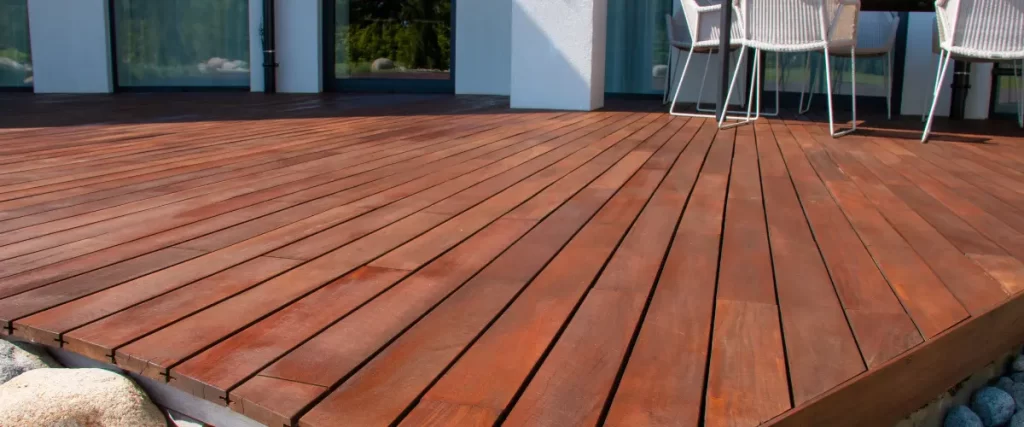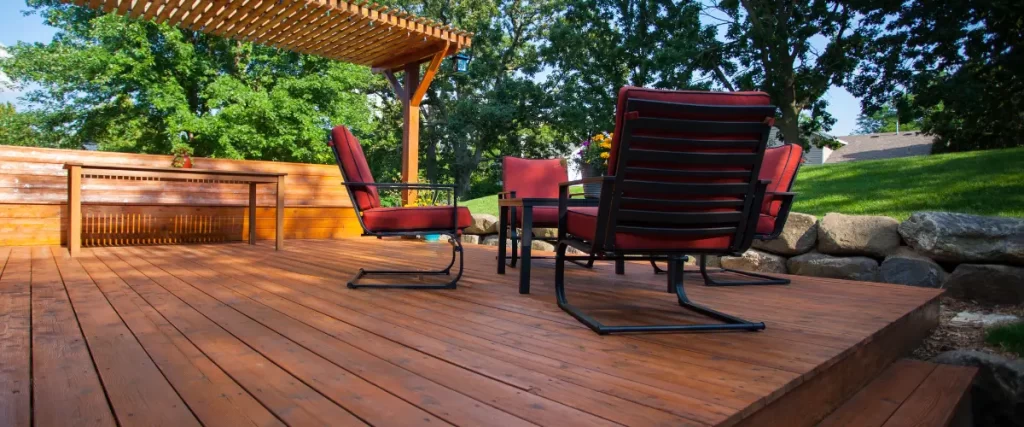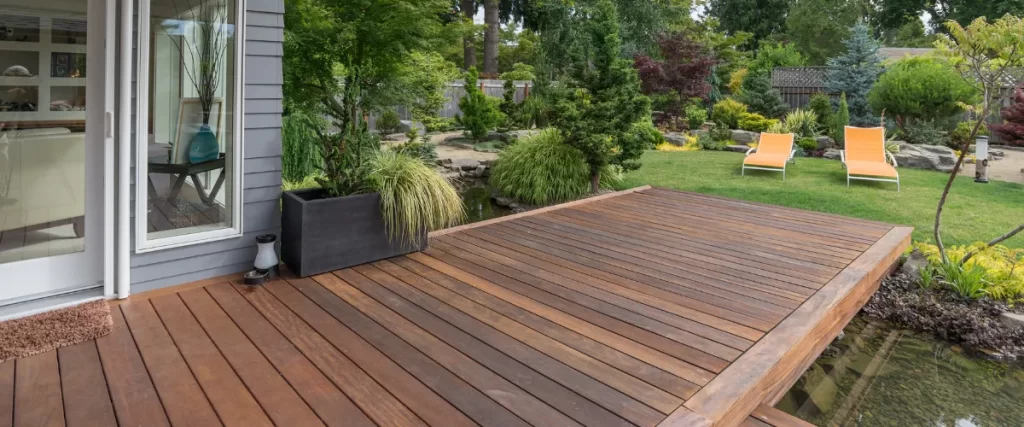If you live near the Tennessee River, you know the beauty that comes with waterside living—but you also know the headaches that can follow. Heavy rains, rising water levels, and sudden floods aren’t just seasonal annoyances—they’re serious threats to your outdoor living space.
Here in East Tennessee, especially in areas like Knoxville, Chattanooga, and the communities hugging the Tennessee River, homeowners often face a unique challenge: how do you build a deck that can withstand Mother Nature’s worst while still looking amazing?
Whether your yard floods once a year or every time it rains a little too hard, you deserve a deck that lasts. In this post, we’ll walk you through the smartest decking solutions for flood-prone properties, tailored specifically for local conditions. You’ll learn what materials hold up best, design strategies that minimize flood damage, and how to stay within code without sacrificing style.
Let’s dive into everything you need to know about building the perfect flood-resistant deck near the Tennessee River.

Why Flooding Is a Real Concern for Tennessee River Homeowners
You’re not imagining it—flooding is getting worse. According to data from the Tennessee Department of Environment and Conservation, seasonal flooding along the Tennessee River has become more frequent and severe in recent years. Combine that with Knoxville’s humid subtropical climate, and you’ve got a recipe for soggy backyards, warped boards, and structural headaches.
But here’s the good news: when you know what to expect, you can design around it. Building or upgrading your deck with flood resistance in mind doesn’t just protect your investment—it gives you peace of mind, no matter the weather.
Key Challenges When Building Decks in Flood-Prone Yards
Before we get into solutions, let’s talk about the challenges:
- Moisture Retention: Constant exposure to moisture can lead to rot, mold, and warping—especially with traditional wood decks.
- Soil Instability: Flooding can wash out footings or erode the soil supporting your deck, compromising its integrity.
- Building Codes: Local regulations (especially in flood zones) often require elevation or specific materials, which can impact your design.
- Access & Safety: Slippery surfaces and unstable stairs pose a risk when water levels rise suddenly.
You don’t want to sink money into a beautiful deck only to see it buckle or rot after one stormy season. That’s why smart planning and the right materials are key.
Best Flood-Resistant Decking Materials for Tennessee River Yards
When it comes to materials, not all decking is created equal. If your home is anywhere near a floodplain or routinely soggy soil, your best bet is to avoid standard pressure-treated lumber and instead go with one of these more durable options:
1. Composite Decking
This is our top choice for flood-prone properties. Made from a blend of recycled wood fibers and plastic, composite decking resists moisture, warping, and insect damage. It also requires very little maintenance.
2. PVC (Plastic) Decking
Fully synthetic and highly water-resistant, PVC decking won’t absorb water at all. It’s a strong option for full sun and wet areas but can get hot in the summer.
3. Aluminum Decking
Yes, you read that right—aluminum. It’s not common, but it’s rising in popularity in flood-prone areas because it’s incredibly resistant to rot, rust, and mold.
4. Modified Wood
This is real wood treated with heat or chemicals to make it more water- and decay-resistant. Brands like Kebony or Accoya are good examples, offering the natural look of wood with increased durability.
Smart Deck Design Strategies for Flood Zones
Let’s talk layout. Even the best materials can fail if your deck isn’t designed with flooding in mind. Here are a few must-have design strategies:
Elevated Decks
Raising your deck above the expected flood line can save it from major damage. Depending on your zone, local code might require it anyway.
Water-Permeable Surfaces
Instead of sealing everything tightly, allow water to pass through. Composite and PVC deck boards often come with grooves or gaps that encourage drainage.
Removable Skirting
Skirting hides the underside of your deck—but in flood zones, permanent skirting can trap water. Consider a removable or vented option.
Strong Footings
Use deep-set, concrete footings or helical piers to keep your deck stable, even if the surrounding soil washes out.
Open Framing
Keep the underside of your deck open to allow water to flow through during floods and to encourage air circulation afterward.

Local Building Codes and Permits: What You Need to Know
Flood zone or not, every deck in Tennessee needs to follow local regulations. If you live near the Tennessee River, there’s a good chance your property is in a Special Flood Hazard Area (SFHA).
Here’s what you should know:
- You may need a floodplain development permit, especially if building on or near regulated waters.
- Decks must typically be built above base flood elevation (BFE).
- Electrical and plumbing fixtures below BFE must be flood-resistant.
- Always check with the Knox County Permits & Inspections Office or your local government before starting construction.
A professional contractor (like us at Riverview Decks) will help you navigate the red tape and avoid fines or costly re-dos.
Best Decking Manufacturers for Flood-Prone Yards
When it comes to flood-resistant decks, quality matters. These manufacturers offer durable, long-lasting materials made to handle wet conditions.
Here are some of the top decking brands we trust:
- Trex: Industry leader in composite decking with fade- and moisture-resistant products.
- TimberTech (AZEK): Known for premium PVC decking that stands up to extreme weather and water exposure.
- Fiberon: Offers eco-friendly composite boards with excellent mold and mildew resistance.
- Deckorators: Innovative mineral-based composite decking that’s both lightweight and extremely durable.
- Kebony: Modified wood that’s sustainable and more water-resistant than untreated lumber.
- MoistureShield: Performs well even in direct ground or water contact—ideal for wet climates.
Maintenance Tips for Decks in Wet or Flooded Yards
Even the best materials benefit from some TLC. Here’s how to keep your deck looking its best, no matter how soggy the season gets:
- Clean debris regularly to prevent mold and mildew buildup.
- Inspect footings and supports after major storms or floods.
- Re-seal or treat wood decks annually if you didn’t go with composite or PVC.
- Trim nearby trees and bushes to reduce excess moisture around your deck.
- Use furniture made for outdoor and wet environments to prevent staining and mildew.

FAQ: Flood-Resistant Decking Near the Tennessee River
What is the best decking material for flood-prone yards?
Composite or PVC decking is usually the best choice. They resist water damage and require less maintenance.
How high should I build my deck in a flood zone?
This depends on your Base Flood Elevation (BFE). Your local building department can provide that number.
Can I use regular wood for my deck?
You can, but it’s not ideal for flood-prone areas unless it’s specially treated or modified wood like Kebony.
Do I need a permit to build a deck near the Tennessee River?
Yes, especially if you’re in a designated floodplain. Always check with your local permitting office.
How can I make my existing deck more flood-resistant?
Consider retrofitting with composite boards, upgrading the footings, and improving drainage under the structure.
Final Thoughts: Build Smarter, Not Just Stronger
Living near the Tennessee River has its perks, but dealing with frequent flooding isn’t one of them. The good news? With the right materials, smart design, and local know-how, you can build a deck that not only survives the storms but thrives through them.
If you’re thinking about building or upgrading your deck, don’t just wing it. You deserve a structure that stands the test of time, weather, and water. Contact us at (865) 801-4545 to get started with your deck building project!
At Riverview Decks, we specialize in decks built for our unique East Tennessee climate and terrain. From design to installation, we’ve got your back (and your backyard).

